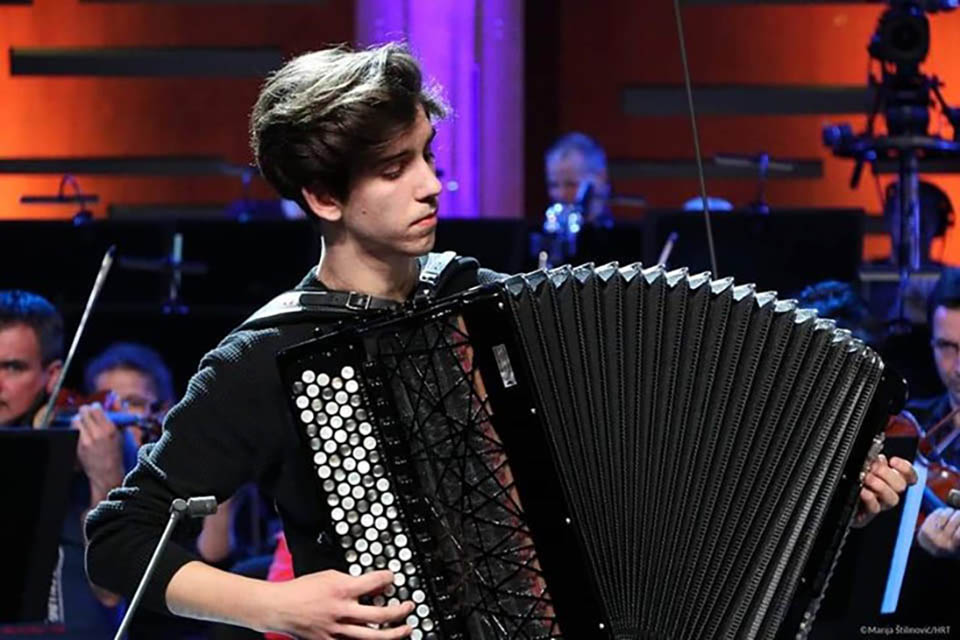
Many years ago, I decided to buy a piano accordion, under the impression that being a reasonably competent pianist, it would be fairly easy to play. I was wrong. The keyboard looked friendly enough, but it was something of a challenge to play the keyboard sideways without getting my fingers in knots. Then there were the left-hand buttons to sort out. Many accordions use the so-called Stradella bass system, in which the buttons are arranged in intervals of the fifth: separate buttons for bass notes and additional rows of buttons for major, minor, dominant seventh, and diminished chords. So far, logical enough.
The trouble is, when playing the instrument, the buttons are unmarked and in any case they’re completely out of sight, so that you have to fumble around until you manage to memorize the positions. My biggest problem was remembering to keep pushing and pulling the bellow with the left arm – an action that doesn’t come naturally, especially as your fingers are busily engaged in other occupations. The accordion is also an incredibly heavy contraption, supported by thick leather straps that go over your shoulders. Compared to the piano, practising is a physical effort.
The accordion is rather loud, which is why it’s popular in dance music. Sadly, it was not popular with my neighbours who were clearly not connoisseurs of accordion music. There were so many complaints that my potential as an international accordion star was never realized. In any case, I never really got the hang of the bellows.
After its invention in 1829, the accordion became enormously successful and it travelled with migrating Europeans to many parts of the world. It was ideal for folksongs and dance music because it could provide harmonies as well as melody. Ironically, this was one of the reasons that the accordion was slow to be accepted into classical music because the buttons could produce only relatively simple chords. The breakthrough came with the emergence of the “free-bass accordion” which could play a wide range of individual bass notes. Accordions are part of a large family of musical instruments known technically as free-reed aerophones and include mouth organs, the ancient Chinese sheng and the Thai khaen. The melodeon, bandoneon and the concertina are really just simpler versions of the accordion.
If the music of Paul Hindemith doesn’t normally float your boat, give this early work a try. Kammermusik (“Chamber Music”) is the title of eight compositions that he wrote during the 1920s. While most German composers of that time were writing romantic nationalistic music, Hindemith was looking forward rather than back and wanted to explore new tonalities and new ideas. This strikingly original work is scored for wind instruments, piano, string quintet, percussion and accordion. It’s strident and provocative music and contains more than a hint of Stravinsky. After the premiere, the 27-year-old Hindemith acquired the reputation of being “the bad boy of music” a description that he probably relished. One reviewer scoffed, “music has finally managed to embrace today’s lifestyle at its most frivolous and vulgar…a kind of music the likes of which no German composer has ever even dared think about, let alone write…music of lewdness and frivolity.”
To modern ears, it is a delight, with touches of humour, some notoriously difficult passages and a wild, vivacious energy that’s difficult to resist.
Ihor Naumovich Shamo (1925-1982): Concerto for Accordion and Strings. Leonardo Rojnić (acc), HRT symphony orchestra (Zagreb), cond. Tomislav Fačini (Duration: 10:17; Video: 480p HD)
Concertos for accordion and orchestra are a bit thin on the ground. The first one was evidently composed in 1937 and since then only a trickle have emerged. It seems that few composers have ever felt the need to write one, though there are examples by American composers Alan Hovhaness, Henry Cowell, Paul Creston and the British composer Gordon Jacob. With the accordion being so closely associated with France, you’d have thought that some French composers would have written a concerto but no one did. But here’s a splendid work by the Ukrainian composer Ihor Shamo, who was born in Kiev. The concerto is superbly and sensitively played by the brilliant young Croatian accordionist Leonardo Rojnić who currently studies at The Sibelius Academy in Helsinki. You’ll notice that he plays a rather complex-looking instrument that uses buttons instead of a keyboard. It’s known as a bayan, a type of accordion developed in Russia during the early 20th century and favored by many professional players because of its richer tone colour and more powerful bass notes.
The performance was recorded at the Croatian National Finals of the Eurovision Young Musicians 2020. Shamo’s concerto is a fascinating work, approachable and in complete contrast to the work of “bad-boy” Hindemith. The Prelude is of simple, flowing melodies, lyrical harmonies and a kind of romantic soul-searching quality. It leads into a sparkling and virtuosic Toccata which demonstrates Leonardo Rojnić’s formidable technical skills. Magic indeed.
 |
 |
 |





